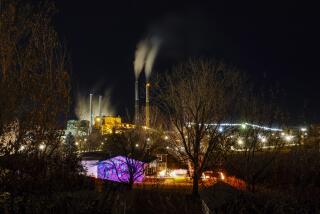Youngstown Learns to Live Without Steel, but Itâs Grim
YOUNGSTOWN, Ohio â Like fire-snorting dragons, hulking steel mills once shot rockets of orange fire and plumes of gray smoke across these skies. Their dirt, stink and noise were the price of prosperity.
But, like dragons, the aging mills faded into myth and history. The sky turned blue, the air fresh, the factory yards grew silent. In Youngstown, these became the signs of adversity.
Ten years have passed since the beginning of the end of steel dominance here. In that decade, thousands lost their jobs, thousands more left. Many of the mills remain, shuttered symbols of the past.
Today, this archetypal Rust Belt city, a town whose chief industry was decimated by competition and technology, is learning to live without steel. It is like a carpenter learning to live without an arm.
âYoungstown put all its eggs in one basket, but it was one helluva basket,â said Bert Cene Jr., a former steelworker. âItâs a very hard lesson . . . when the basket breaks. But when you learn the rough way, you donât forget it.â
The Youngstown area lost 41,000 factory jobs, about 20% of all its jobs, in the 13 years ending in 1986. Most of the loss occurred in the last decade.
Four of every five steel jobs disappeared. So did Mahoning Valley giants such as U.S. Steel Corp. and Youngstown Sheet & Tube Co.
Probably no city in America is more familiar with the plight of displaced workers than Youngstown. Recent studies have estimated continuing unemployment among former steelworkers from 27% to nearly 47%.
âProbably the Worst Caseâ
âIf you want to see the effect of mass unemployment on a community . . . Youngstown is probably the worst case you can think of,â said Terry Buss, director of the Center for Urban Studies at Youngstown State University.
And probably no city knows better how hard it is to bounce back from such devastation. Youngstown is trying to do that--to shed its image as a dying steel town and rebuild as a city with a diversified economy, new industry and smaller companies with 50 to 100 workers instead of large plants.
How much progress has been made is debatable. A $4.5-million Avanti auto plant is set to begin production this fall. Millions of dollars have been pumped into the city, and some small businesses have started up--evidence, some say, that Youngstown is recovering.
âWe are moving in the right direction,â said Mayor Pat Ungaro. âWeâve got a long way to go.â
Jobless Rate Drops
Area unemployment is down--9.6% in May, a sharp drop from 1982, when it lead the nation at 23%. Labor experts and academics, however, say the real jobless rate is closer to 15%, more than twice the U.S. average, but official numbers are lower, partly because people who give up looking for work arenât counted.
The city has shrunk, too, as the suburbs have grown. Current population is about 105,000, contrasted with 168,237 in 1950 and 140,909 in 1970. And when people go, so do businesses. Downtown Youngstown has no hotel or department store.
âI think itâs in a deep sleep,â said Staughton Lynd, a labor historian and attorney at Northeast Ohio Legal Services who was active in the fight to keep the mills open. âAll of this upward and onward talk is just boosterism.â
There may be no stronger indicator of Youngstownâs steel decline than a list of the employers who pay the most city income taxes. In 1976, the first three in the top 10 were steel companies; in 1986, all three were gone, said Gary Kubic, finance director.
Survivor in Bankruptcy
The only steel company on the 1986 list, he added, was at the bottom--LTV Steel, in nearby Warren, a subsidiary of LTV Corp., which filed for Chapter 11 bankruptcy last year.
In Youngstown, some idle mills have been razed. The mayor says itâs time to tear down the others along the Mahoning River.
âIâm saying itâs dead,â said Ungaro, a former assistant high school principal and football coach. âLetâs get rid of it. Iâm tired of looking at it. Letâs use that land.â
The mills are reminders of what once was and what can never be again. They stand in weed-filled yards. Along Wilson and Poland avenues, where thousands once sweated day and night at furnaces glowing with molten metal, there is quiet.
Eyesores are one problem. Attitude may be a bigger one. Even people who are doing well bad-mouth the city, Ungaro said.
Many Want Out
âIf you walked down the street and talked to 10 people from Youngstown, I bet seven or eight would say itâs finished,â said ex-steelworker Cene, who runs a jobs assistance program. âI hear it all the time, âIâve got to get out of here.â â
For some who stay but have no work, welfare is a way of life, a night out is an out-of-reach luxury, a job with double-digit hourly wages is a fantasy.
âIf you want to go down and have a few beers, you canât do that. You canât go to bingo,â said Anthony Porrazzo, an unemployed steelworker who said he hadnât eaten a restaurant meal in three years.
âYouâre not living. Youâre just existing,â he said. âEver see the old zombie movies? People are just walking, their minds are far away. I catch myself sitting and just staring in space. I can see how a man can be an alcoholic or contemplate suicide.â
Psychology of Welfare
Porrazzo said he was forced to go on the welfare rolls in 1984 after he spent $20,000 in savings. âIt was real difficult,â he said. âIt makes you feel less a man, not a provider, not a husband, not a father.â
Another unemployed steelworker, Mark Bowles, also turned to welfare, receiving $101 in aid and $81 in food stamps each month, but finally landed a job at a bakery this summer.
He said he is not sure whether he will be asked to stay, so he spends little of his money. âIâm putting it in the drawer,â he said.
Bowles, 34, drives a 1978 Dodge with more than 100,000 miles on it, but he rides his bicycle often, sometimes past the line of old mills.
âItâs like a museum to me,â he said. âItâs amazing it would vanish like that.â
New Jobs Pay Far Less
But it did. And so did Youngstownâs reputation as a strong union town with $14-an-hour steelworker salaries. Most new jobs pay $6 to $8 an hour.
Out-of-work steelworkers were reluctant to accept lower wages at other jobs but gradually faced reality, said Mike Connelly, director of Youngstownâs Employment Training Corp., which pays for on-the-job training.
He also said they didnât start coming to his program until 1982, five years after the first big closing, that of Youngstown Sheet & Tube.
Buss, who has studied Youngstown steelworkers, said few seek help in finding new jobs because most retraining programs offer only entry-level skills and last several months without promise of employment.
It also took time for the city to accept steelâs demise.
âLike Losing a Loved Oneâ
âFor several years, we were fighting to bring the mills back,â Ungaro said. âItâs like losing a loved one. We didnât accept it.â
Proposals to reopen the mills under worker-community ownership or convert them into a national research steel center failed to materialize. So did other business projects, including one to build an American version of a Soviet commuter jet. A dirigible factory and a brewery also were considered.
Kubic said the city is now trying to lure business with grants and tax abatements. Ungaro said $35 million in private money has been spent in the last two years in renovating former stores and downtown office buildings.
There is some small-scale steel too, including the North Star Steel Ohio mini-mill, which started up in 1986 and employs 150 non-union workers.
General Motors Corp. has a plant in nearby Lordstown, and the Avanti plant is set to begin production on its finned, fiberglass-body car. Cafaro Co., a local developer, bought half of Avanti for an undisclosed sum on the understanding that the plant, Avantiâs second, be built in Youngstown. By the fall of 1990, it is expected to employ about 480 workers.
Breaks 10-Year Trend
âJust the excitement of something happening here in terms of the loss of jobs in the last 10 years, itâs a real shot in the arm,â said Phillip Richley, former mayor and vice president for development with Cafaro.
Though these businesses are smaller than the old mills, they are important.
âTo reactivate the economy, you have to do more than expect some savior to come in and start a plant and hire thousands of people,â said David McBride, director of the Cushwa Center for Industrial Development at Youngstown State.
âYoungstown,â he added, âforgot what history teaches us--that nothing lasts forever.â
Reluctant to Blame
But Cene said those who believed otherwise shouldnât be blamed.
âEverybodyâs got 20-20 hindsight,â he said. âYou can now say we should have diversified, we shouldnât have put all our faith in steel. You canât blame the people. Itâs your tax base, itâs your blood. . . .
âI donât think anyone was wrong. It was here 100 years; we thought it was going to be there 100 (years more).â
More to Read
Sign up for Essential California
The most important California stories and recommendations in your inbox every morning.
You may occasionally receive promotional content from the Los Angeles Times.










